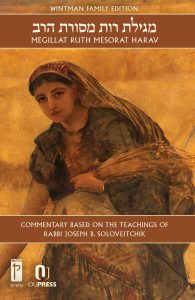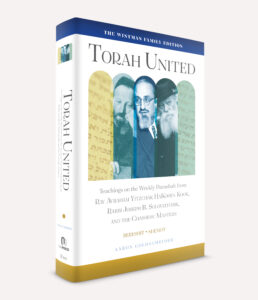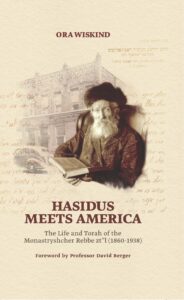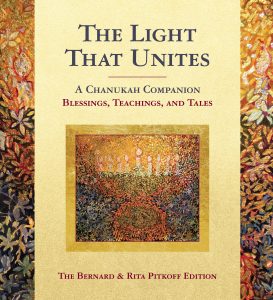Excerpted from Rabbi Dr. Norman J. Lamm’s Derashot Ledorot: A Commentary for the Ages – Genesis, co-published by OU Press, Maggid Books, and YU Press; edited by Stuart W. Halpern
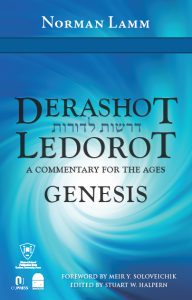 An Old Shirt for a Young Prince*
An Old Shirt for a Young Prince*
When our father Jacob was on his deathbed and just before he blessed all his children, he called over his favorite son, Joseph, and told him that he was giving him a special award, something the others would not get. “Son,” he told his royal child who was now effectively the master of Egypt, “I have given you an extra portion over your brothers” (Genesis 48:22). The Torah does not say what that portion is. But our rabbis (Targum Yerushalmi, Genesis 48:21) suggested what that extra legacy
was. Rabbi Yehuda maintains that it was the garment worn by Adam!
What a gift to give a king! That an inheritance for a man who controlled the greatest kingdom of antiquity, who had millions under his thumb, who regulated the commerce of the whole nation, who was an absolute potentate who had all that he wanted at his command: a shirt, and an old one at that! It was quite a buildup Jacob gave for what turns out to have been merely a family heirloom. A shirt twenty-three generations old may have some sentimental value, it may be of archeological value. You may give it to other children, or to a museum; but you don’t give that to a fabulously wealthy viceroy as a “special” reward.
But if that is what Jacob decided to give to Joseph, according to our sages, there must have been some very special reason for doing so. Our rabbis meant to tell us something of what Jacob wanted to teach Joseph, and the Josephs of all ages. There are three descriptions of that garment worn by Adam which indicate three major points that we must take to heart and remember. They are three lessons Jacob wanted to drive home to Joseph – because he was the wealthiest and most powerful of all his children – three correctives to the abuses that come so frequently with the acquisition of prosperity, power, and social recognition.
The first thing our rabbis said of this piece of clothing was that it was made of a special kind of leather. The Bible calls it “katnot or” (Genesis 3:21), a leather garment. And the rabbis add that it came from the skin that the serpent shed off. Joseph, he told him, I am afraid that your wealth or power is going to go to your head. You have every reason in the world to be proud of yourself. You started as a slave in a miserable prison, sold down the river by your brothers. Now you’ve achieved political eminence, economic domination of an empire, and social recognition, being heralded by all Egypt as its savior, and crowned by Pharaoh himself as second to him alone. You have money, you have real estate, you have power. You have, in other words, the greatest temptation any man can ever have – to lose his humility. You ride around in golden chariots; you are a titled prince; you are a shrewd businessman; the Egyptians may not want to break bread with you because you’re a Jew, but still, you have made yourself your own palace. But don’t forget, Joseph, don’t forget that it doesn’t mean a thing. Don’t you ever pride yourself on being a self-made man. No man is self-made. His power is a dream. His wealth is illusory. His shrewdness is only in his imagination. His eminence is transitory. It’s all a great spiel, nothing else. And just as a reminder, son, here, take this old, tattered snakeskin shirt and frame it and hang it on your living room wall for everyone to see. Every once in a while take a look at it. And let you and your descendants and all men forever remember that the original owner of that shirt once had a complete Paradise in which to disport himself. He had Trees of Knowledge and life, and had gold and silver. He must have thought it was all his – that he was self-sufficient – and he could live as proudly as he wanted to. But then remember that he was chased out of Eden, and he was left with nothing, not even a shirt on his back. And then, only through the goodness of God, was he given a garment to wear. And, Joseph, my princely and wealthy and powerful son: where do you think even that one shirt came from? Adam’s own work? His handicraft? Nonsense. It came from the skin the snake sloughed off. Man, despite his delusions of grandeur, is ultimately only a parasite!
Remember, Josephs of all generations: you’re not self-made, you’re God-made. Forget your golden chariots or your Cadillacs; forget your empire-building or business sense; forget your social status, whether in ancient Egypt or modern America. Remember that whatever you have came from someone else, that even the shirt you wear came from the hair of a sheep or the skin of a snake or the back of an underpaid cotton picker down South. Use your power and wealth and all you now have, but use it with humility. Keep the snakeskin in front of you, Joseph. It’s the greatest gift you can receive. It’s the only thing that will help you keep your balance and keep you from submitting to that great abuse of prosperity: the belief that you are a god and that you are self-sufficient.
The second thing our rabbis said about that garment was regarding its design. It had, drawn upon it, pictures of birds flying. Here was the corrective to a second, and very unusual and unexpected kind of difficulty that power and prosperity bring in their wake. One writer, I think it was Max Lerner, has maintained that in the history books of the future, our age will not be called the Atomic Age or Hydrogen Age or any other such name. It will be called the Age of the Ulcer. With increasing prosperity and with the higher standard of living, we have inherited a whole line of diseases caused by the anxiety that grips us. In ages gone by people hardly ever experienced or even knew of that whole array of illnesses we now call by that fancy name, “psychosomatic diseases” – something our ancestors would have preferred to call “an aingerreter krenk.” Why the plague of migraines, the necessity of visits to a psychiatrist, the ubiquitous ulcer? It is because we do not know quite what to do with our power and our money, and because we are always seeking to increase it – and this, because of another fear: that if we don’t get more, we’ll lose all we have. In the midst of all the luxurious blessing, we feel a curse – a sort of obsessive unhappiness, a neurotic anxiety and, of course, the ulcer. What good are all these things if the price we must pay is stewed prunes, sweet cream, and amphojel? We have better beds and mattresses, but can’t sleep at night. Wonderful new reclining sofas, but we are no longer able to sit back and relax, so tense are we. We have television even in color, and can’t even force a sincere laugh out of our systems; we’re too worried to be able to be happy. We rack our brains devising timesaving devices – and then, when we do get home earlier, we take along the office in our minds and our phones, and leave no real time for our families. We’re unhappy, busy, nervous, anxious, and – of course – ulcerous.
“Joseph,” Jacob must have told his great son, “Joseph, don’t fall victim to these plagues. Don’t destroy the value of your greatness by submitting to the anxiety that goes with it. Here’s Adam’s garment. He had lost every penny, been driven out of a Paradise, forced to go to work – manual labor, no less – and had nothing to his name but this garment. And look: he managed to remain so happy and satisfied with his simple life that he drew the figures of birds in flight, the symbols of careless happiness, of unconcerned joy and a feeling of uninhibited and un-anxious well-being. Remember, son, after your day of business is done, be done with it. Don’t worry about losing it. Just relax, trust in God who gave it to you to keep it for you, and don’t get sick looking for amusement. Just determine always to be happy with what you have. Let your mind be as free as a bird, though all you may have after all is only a shirt.” “When a king is at a celebration,” said the Mezeritscher Rebbe, “he is approachable to many people who otherwise would be denied admittance to the palace. Likewise, when we serve God with joy, He is more approachable.”
And finally, the third thing our sages had to say about this ancient garment worn by Adam was that it was no ordinary garment at all. It was, they maintained, bigdei kehuna, the robe of a high priest, worn while serving God, first used by Adam, then down the ages through Abraham and Isaac and Jacob and now being given to Joseph. That garment, in short, was the symbol of religious tradition. It was the service and worship of our one God, being transmitted from father to son, spanning all human history from its very beginnings. Oh how worried Jacob must have been when he took leave of his earthly existence and of his twelve sons. Joseph must have troubled him more than all the others. Such a wonderful son, such a clean-minded, upright young man of true integrity and fear of God. How would he fare when tested with wealth and might? Had he, perhaps, in all this luxury and regal splendor, forgotten his old father and his Eternal God? “What about these two young sons of Joseph I just blessed?” Jacob must have thought. “What is to become of them in this land of Egypt? Will they assimilate? Will they be Egyptian like all Egyptians, and angrily maintain that they are no different from other Egyptians who worshiped the sun as it rose on this Nile valley?” Joseph had to have a reminder with him at all times. And so Jacob gave him this high-priestly vestment, first worn by the first man. Religious responsibility, he meant to tell him, does not decrease with increased substance; it increases. Here, Joseph, is this yellow- greenish, ancient-looking, outmoded, outlandish, and, to Egyptian eyes, ridiculous-looking little robe. Wear it, Joseph. Maybe this garment of Adam, the robe of the high priest, doesn’t go well with your royal purple. Maybe a brand new, shiny, and attractive Egyptian robe would look nicer and be more appealing to your young folks who never saw or understood the religious tradition of Adam and Abraham and Isaac. Maybe so, but this is yours, and now you’re to wear it.
Even more than arrogance and unhappiness, the greatest victim of our American Jewish prosperity has been our religious tradition. It hasn’t always looked good beside the shiny brassiness of our newfound wealth. Some of our non-Jewish neighbors might have snickered at it – or so we thought. The tallis hasn’t always matched up to our tuxedos and riding habits and minks. And so we scrapped it. We disinherited ourselves from the ancient mantle which came down to us through the ages. We now wallow in the fat of the land – and the priestly garments lie somewhere unknown and un-mourned. I have been stressing the outlandish and old-fashioned look of this garment of Adam, precisely because this is the test of the Jew. Any child will automatically grab for that which is new and shiny and colorful. The test of Jewish maturity is to hold to the heart the old mantle, perhaps to polish it up, but never to exchange it. The Jew who is ashamed of it because it is so ancient looking is not an authentic Jew. Ludwig Lewisohn has given us an excellent description of the authentic Jew when he said that it depends on your reaction when walking with gentile friends through New York’s East Side and seeing bearded, kaftan-robed and shtreimel-decked Jews running to Minĥa. If you feel uneasy and embarrassed, you’re not an authentic Jew, just like the Catholic ashamed of the robed nun is not an authentic Catholic. You can test it right here in Springfield. If you’re ashamed of being identified with your religion on Main Street, then – sorry to say – you’re not a full Jew. The true test of authenticity is to be as Americanized as Joseph was Egyptianized; as wealthy and mighty as Joseph – and still to proudly wear the mantle of your religious tradition.
“I have given you an extra portion over your brothers” – it is only one more trifle than the others received. But it is that one garment of Adam, with its triple message of humility, happiness, and holiness, which can spell the difference between successful, satisfying Jewish living, and abortive, unsatisfying, and un-Jewish living. The Torah offers it to us, even as Jacob offered it to Joseph. Let us not wait. Let us extend our hands, open our hearts, and take it – with humility, with happiness, and in holiness.
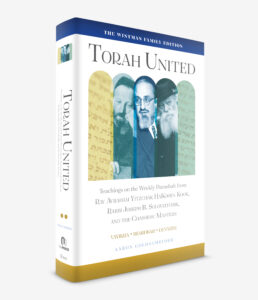 Second Chances
Second Chances
